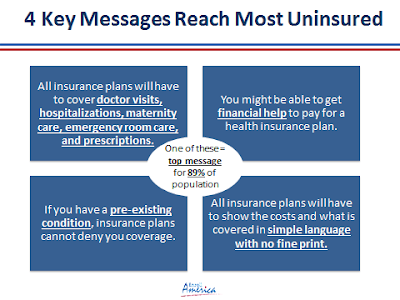What to say when you talk about health reform
by Nicole Johns
by Nicole Johns
Sept. 26, 2013
Everything I am about to say comes from the great work of Enroll America. Those folks have done the research and pulled it all together so we can use it to make sure all Americans have the affordable quality care they need. So check out all of their resources for everything you need to plan your outreach and enrollment work.
The health reform law is so confusing and complicated. It doesn't surprise me that so many people feel like its just too much to understand, let alone do anything. So I'm going to try to break it down into some simple messages for you to share with people you want to encourage to sign up through the Marketplaces. (If you don't know what a Marketplace is, then start with this fun and simple video.


This refers to the 10 Essential Health Benefits. You can learn more about them here.
People with income between 100% FPL and 400% FPL (Federal Poverty Line) will be eligible for tax breaks to pay for premiums. There is also help for some people to cover co-pays. You can learn more about ways to make health coverage affordable here.
Health insurance companies cannot discriminate against anyone based on health status or pre-existing conditions, including HIV, cancer, diabetes, or any other chronic condition or infectious disease. More on these protections here.
The health care law requires all coverage information to be simple, clear and comparable. So you can compare plans for the different services, doctors, and limits. No small print allowed.
Healthcare.gov is the place to go to learn about the Insurance Marketplaces and how to access insurance. Here's a great place to start to figure out what kinds of information you need to enroll and how to compare your options.
This website is supported by the Health Resources and Services Administration (HRSA) of the U.S. Department of Health and Human Services (HHS) as part of an award totaling $20,808,001. The contents are those of the author(s) and do not necessarily represent the official views of, nor an endorsement, by HRSA, HHS, or the U.S. Government. For more information, please visit HRSA.gov.